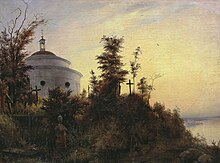Askold's Grave
- For the opera, see Askold's Grave (opera)


Askold's Grave (Аскольдова могила) is a historical park on the steep right bank of the Dnieper River in Kiev. It was created by the Soviets in the mid-1930s in place of an old graveyard around the Church of St. Nicholas, which, as the story goes, marks the place where Prince Askold of Kiev was buried in the 9th century.[1]
In the Middle Ages, Askold's Grave was known as the Hungarian urochishche ("plot of land", "tract"). According to the Primary Chronicle, it was the place where the Magyars crossed the Dnieper on the way from the Russian steppes to Pannonia. Archeological excavations have revealed a 9th-century dirham hoard and some remains of Izyaslav II's wooden palace. There's a modern stele commemorating the Magyar migration.
Back in the 15th and 16th centuries, Askold's Grave was settled by the Orthodox monks of St. Nicholas's Monastery. Hetman Mazepa had the monastery moved to a nearby hill where a new Baroque penticupolar cathedral was then erected. The existing church of St. Nicholas "Slupsky" is a modest Neoclassical rotunda designed by local architect Andrey Melensky in 1810.
A new golden-domed chapel was built on the bank of the Dnieper in 2000. The style is Ukrainian Baroque revival.[2] The chapel is dedicated to Saint Andrew Protokletos and belongs to the Ukrainian Orthodox Church (Moscow Patriarchate).[3]
References
External links
 Media related to Grave of Askold at Wikimedia Commons
Media related to Grave of Askold at Wikimedia Commons
